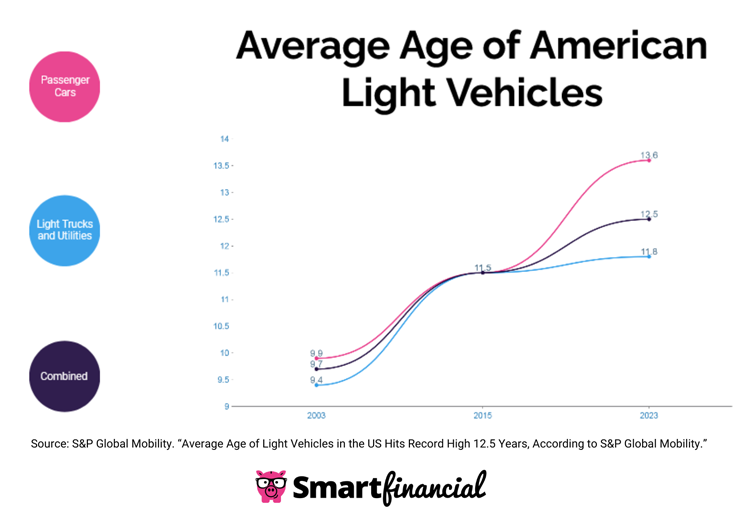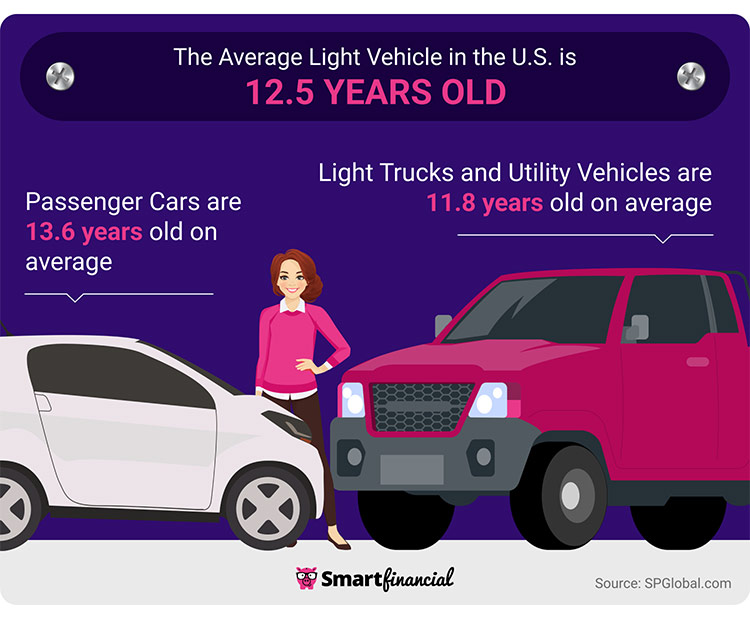The Average Age of Vehicles on the Road Continues To Go Up Through 2023
 Editorial Standards
Editorial Standards SmartFinancial Offers Unbiased, Fact-based Information. Our fact-checked articles are intended to educate insurance shoppers so they can make the right buying decisions. Learn More
The average age of vehicles on the road in the United States is at an all-time high of 12.5 years as of 2023. Economic downturns, improving vehicle quality, technological advancements and rising new car prices have contributed to the trend of American drivers keeping their cars for longer.
Keep reading for more information about the average age of cars in the U.S. and what steps you should take to keep your vehicle on the road for as long as possible.
|
Key Takeaways
|
Average Age of Cars in the U.S. in 2023
The average light vehicle in the U.S. is 12.5 years old according to a 2023 analysis from S&P Global Mobility. This is the highest average vehicle age that S&P Global Mobility has ever recorded.[1] Keep in mind that this average excludes tractor-trailers, buses and other heavy vehicles.

Furthermore, the average age of vehicles on the road can be broken down into two categories for different types of cars. Passenger cars are 13.6 years old on average while light trucks and other light utility vehicles are 11.8 years old on average.[1]

Why Does This Matter?
While it may come at the expense of car dealerships, the rising age of the average American vehicle is a definite plus for the automotive service industry. Since older cars generally require more maintenance, repair shops should expect to see more business as drivers opt to hang onto their vehicles for longer periods of time.[1]
In addition, this trend could lead to lower car insurance prices. An older car is generally cheaper to insure than a newer one since it is less valuable, meaning the insurance company would not have to pay as much in the event of a total loss. As the vehicles in operation get older, average insurance rates could eventually drop since the average driver would be less likely to file a costly car insurance claim.
People in the U.S. Are Keeping Their Cars Longer
Some of the reasons why American drivers are keeping their cars longer include economic trends, the improving quality and technological capabilities of vehicles and the increasing cost of new cars.
The Economy
Consumer demand for big-ticket items went down in 2022 due to inflation and rising interest rates.[1] Across the board, prices were 8% higher on average throughout 2022 than they were in 2021.[2] With groceries, gasoline and other everyday expenses costing more, many Americans had less room in their budgets for expensive purchases like new vehicles, making them more apt to keep their current vehicles or buy used cars instead.
In addition, the Federal Reserve attempted to combat inflation by raising interest rates nine times from March 2022 to March 2023.[2] By raising interest rates, the Federal Reserve aimed to discourage people from taking out loans, which would lower demand for high-priced goods and eventually lower prices. However, the more immediate impact of these interest rate hikes was making it harder for Americans to finance new vehicles.
Improved Vehicle Quality & Technology
Cars are also lasting longer than they used to because they have been designed to be more durable and include more advanced technological features. J.D. Power found that cars were more dependable in 2021 than at any other point since the company began keeping track in 1990.[3] After redesigning the study in 2022, J.D. Power found that vehicle dependability improved once again in 2023.[4]
Meanwhile, new technologies and safety features have become more commonplace, making it easier to avoid accidents and subsequent insurance claims. For example, backup cameras became a requirement for all new light vehicles in 2018.[5] In addition, features like automatic emergency braking and blind spot detection have become increasingly popular and contributed to the improved longevity of cars over the past decade.
In the near future, new cars will be required to come with impaired driver detection technology that can limit drunk driving accidents and potentially cause the average age of cars in the U.S. to grow even older in the decades to come.[6] Similarly, anti-theft devices have made it easier for drivers to avoid filing comprehensive insurance claims due to car theft.
It Costs More To Buy Newer
All other factors aside, new vehicles are becoming more and more expensive to buy. New car prices have risen by over 17% since 2020, thanks in part to decreasing domestic auto inventories.[7] This issue is exacerbated by the ongoing chip shortage, which is impeding supply chains and lowering new vehicle production, thus resulting in a higher demand for new vehicles relative to the supply.
Cars That U.S. Drivers Keep the Longest
The Toyota Land Cruiser, Chevrolet Corvette and Mercedes-Benz SL-Class are the top three cars that Americans keep the longest on average. Overall, Americans tend to keep cars that were purchased new for 8.4 years on average.[8]

Gas Vehicles Will Face an Uncertain Future
The federal government and other regional governments have taken steps to increase access to electric vehicles (EVs) and decrease reliance on gas-powered vehicles. For example, President Joe Biden established EV tax credits by signing the Inflation Reduction Act into law and set a goal for half of all new vehicles sold in the U.S. to be electric by 2030.[9]
The California state government has taken even more aggressive action, requiring that all new vehicles sold in California be zero-emission by 2035. However, California drivers will still be allowed to drive and resell gasoline cars after 2035.[10]
However, considering the average age of EVs went down from 2022 to 2023 while light vehicles on the whole became older, it’s unlikely that gas vehicles will be totally phased out any time soon.[1]
Tips To Increase the Life and Longevity of Your Vehicle

You can maintain the quality of your vehicle and improve its longevity by taking steps like these:
- Practice safe driving habits: Sudden braking can reduce your gas mileage, overheat your brake pads and damage your brake hoses, among other things.[11] As a result, it’s important to drive the speed limit and pay attention to the road at all times. Installing advanced safety features can also lower the odds that you will get into an accident that will cause major damage to your car.
- Keep up on vehicle maintenance: You should take your car to an auto shop for regular tune-ups and oil changes, change the air filters as necessary and regularly check your tire pressure and fluids to keep your car in the best shape possible.
- Wash your car often: Dirt, pollen, salt and more can ruin your car’s paint job and potentially lead to rust that will damage the frame of the car itself. For this reason, you should wash your car frequently to keep these things from building up.
- Don’t ignore warning signs: If you hear a rattling noise or some other unusual sound while driving your car or notice that one of the dashboard warning lights has come on, it’s best to have your car checked immediately rather than waiting for a mechanical breakdown to occur.
- Drive regularly: Your car’s batteries, tires, fluids and fuel can all become less effective if you let your car sit for more than two or three weeks at a time. To avoid these problems, you should regularly drive your vehicle for at least 10 minutes, ideally reaching 65 miles per hour for at least part of the drive.[12]
- Insurance quotes /
- Auto /
- Average Age Of Car In Us






